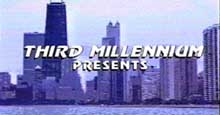Methoden
Die hier beschriebenen Methoden lassen sich bei der Arbeit mit einer Reihe von Medientexten, Film- und Fernsehtexten aber auch Videospielen, effektiv im Unterricht einsetzen. Sie helfen, die Konventionen und Codes der audiovisuellen Gestaltung aufzuzeigen, und die vielfältigen Beziehungen zwischen Text, Produzent und Publikum aufzuzeigen.
Learning Objective
Pupils should
learn that:
• Title sequences identify the text and ‘sell’ it to audiences; they may be very explicit about the text’s genre, content, audience and purpose or they may disguise this to provoke curiosity.
• Information about who made a text, who financed it, and who owns it, can alert you to the interests it represents – and those it may not represent, or may misrepresent.
• Many roles may contribute to the production of a moving image text and can affect its content, style and meaning.
• A moving image text is likely to be produced by one company and distributed by another.
• Title sequences identify the text and ‘sell’ it to audiences; they may be very explicit about the text’s genre, content, audience and purpose or they may disguise this to provoke curiosity.
• Information about who made a text, who financed it, and who owns it, can alert you to the interests it represents – and those it may not represent, or may misrepresent.
• Many roles may contribute to the production of a moving image text and can affect its content, style and meaning.
• A moving image text is likely to be produced by one company and distributed by another.
Key Questions
• Is this a
cinema film or a TV programme?
• Is it fact or fiction?
• Who is it for?
• What is it about?
• Who made it?
• Who owns it?
• Why might it have been made?
• What roles were involved in making it?
... AND HOW CAN YOU TELL?
• Is it fact or fiction?
• Who is it for?
• What is it about?
• Who made it?
• Who owns it?
• Why might it have been made?
• What roles were involved in making it?
... AND HOW CAN YOU TELL?
A und O (Top and Tail)
Die Titelsequenz einer Filmes wird gezeigt und mit Hilfe von "Freeze Frame", "Bild und Ton" oder "Spot the Shots" identifizieren die SchülerInnen das Genre, das Zielpublikum, und versuchen den Inhalt und die "Botschaft" zu erraten bzw. vorherzusagen.
Der Nachspann oder Vorspann mit den Produktionsangaben wird gezeigt und die hier bereitgestellte Information diskutiert: die Quelle und die "Autoren", die Eigentümer, die Produzenten, der Vertrieb.
Source: Übersetzt und adaptiert von Moving Images in the Classroom. Bfi British Film Institute
